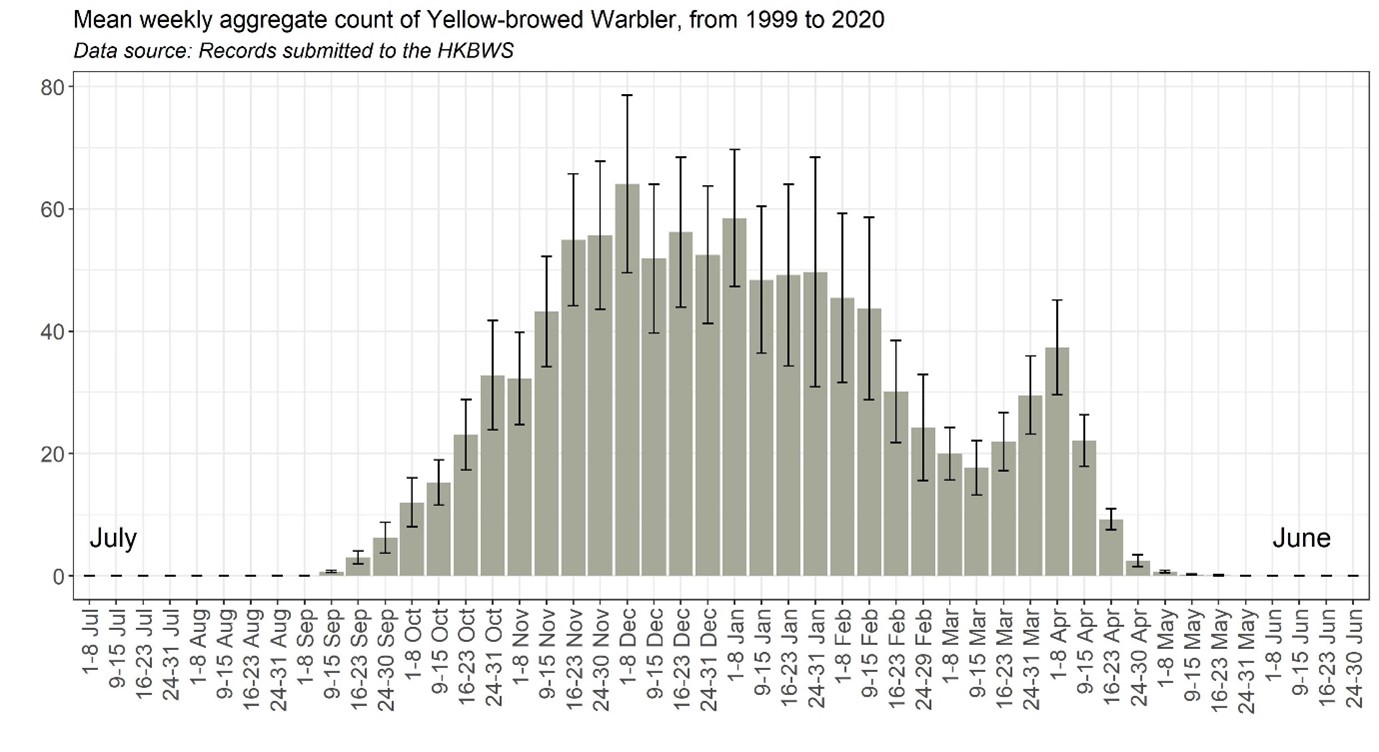Yellow-browed Warbler Phylloscopus inornatus 黃眉柳鶯
Category I. Common winter visitor and passage migrant to diverse areas of shrubs or trees.
IDENTIFICATION

Nov. 2008, Michelle and Peter Wong.
10-11 cm. Distinguished by obvious and usually broad whitish edges to tertials, two distinct wing bars formed by broad tips to median and greater coverts highlighted by dark bases to greater coverts and secondaries, narrow pale edges to flight feathers and tips to primaries, mottled ear coverts, pale supercilium, reddish-brown legs and dull bill with paler base to lower mandible. As winter progresses becomes duller and pale wing bars and feather tips wear to become less obvious. Very distinctive call is a characteristic sound of woodland in winter, at least up to the new year.
VOCALISATIONS
The typical call is very distinctive, a rather high-pitched and disyllabic 'choo-wee' or ‘tsee-wee’, with the second syllable rising to a higher pitch than the first.
The song can be heard in early spring, either in its full form as in the following recording or as a shorter or degraded low-intensity song.
DISTRIBUTION & HABITAT PREFERENCE
Yellow-browed Warbler is a common and widespread species that is found in all areas of forest, shrubland or other wooded areas, including urban parks and mangroves.
There was no significant difference in the percentage of occupied 1km squares in the winter atlas surveys of 2001-05 and 2016-19: 58.2% in the former and 57.1% in the latter. Highest densities in both surveys occurred on HK Island and Tai Po Kau.
OCCURRENCE
Common and widespread, largely from end of September to end of April. Extreme dates are 8 September 2006 and 18 May 2007.
In autumn there is a steady increase in numbers to a peak from the second half of November to the first week of January (Figure 1). There follows a decline that initially is related to the onset of prolonged cold weather, when birds depart HK presumably for areas further south and west. It is at this time that moribund individuals are noted, indicating some mortality during these cold-weather events.
The continuing decline after mid-February probably relates to northward departure of wintering birds. There is a distinct spring passage from mid-March to mid-April, though there is no doubt an element of enhanced observer reporting at a time when the species is known to be uncommon. Numbers decline rapidly during the second two weeks of April and there is only a trickle of reports in May.
The highest counts are 100 in Aberdeen CP on 12 December 1993 and 65 at Tai Po Kau on 8 December 1991, with the highest count since 1999 being 60 at Tai Tam CP on 8 December 2015. Trapping data show inter and intra-season site-fidelity.
After being described by Vaughan and Jones (1913) as the commonest ‘willow-warbler’ in Guangdong during the winter months, arriving in the third week of September and departing in April, it was barely reported during the 1930s. Subsequently, however, it was noted by Herklots (1953) and Walker (1958), who regarded it mainly as a passage migrant; the latter author also referred to ‘many birds wintering in the New Territories’.
BEHAVIOUR, FORAGING & DIET
Forages in typical unceasing Phylloscopus manner below the canopy of trees and in shrubs; rarely forages low down except in prolonged cold weather when it can be seen in atypical habitats such as channelised watercourses. Prey items include insects and spiders. Joins mixed foraging flocks in winter but does not forage in loose flocks in the manner of Pallas’s Leaf Warbler. May be partially territorial in winter.
RANGE & SYSTEMATICS
Monotypic. Breeds over large area of Siberia from the Urals east to Chukotka, generally from the Arctic Circle south to north Kazakhstan in the west and northeast China in the east; winters from northeast India to south China, south through Indochina to peninsular Malaysia (Clement 2020). In China winters largely south of the Yangtze, rarely as far north as Beijing (Liu and Chen 2021, Birding Beijing 2022).
CONSERVATION STATUS
IUCN: Least Concern. Population trend stable.
Figure 1.

Birding Beijing (2022). https://birdingbeijing.com/the-status-of-the-birds-of-beijing/ (Accessed 22 September 2022).
Clement, P. (2020). Yellow-browed Warbler (Phylloscopus inornatus), version 1.0. In Birds of the World (J. del Hoyo, A. Elliott, J. Sargatal, D. A. Christie, and E. de Juana, Editors). Cornell Lab of Ornithology, Ithaca, NY, USA. https://doi.org/10.2173/bow.yebwar3.01
Herklots, G. A. C. (1953). Hong Kong Birds. South China Morning Post, Hong Kong.
Liu, Y. and Y. H. Chen (eds) (2021). The CNG Field Guide to the Birds of China (in Chinese). Hunan Science and Technology Publication House, Changsha.
Vaughan, R. E. and K. H. Jones (1913). The birds of Hong Kong, Macao and the West River or Si Kiang in South-East China, with special reference to their nidification and seasonal movements. Ibis 1913: 17-76, 163-201, 351-384.
Walker, F. J. (1958). Field observations on birds in the Colony of Hong Kong. Hong Kong Bird Watching Society, Hong Kong (duplicated).

